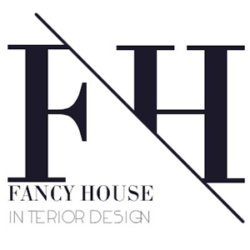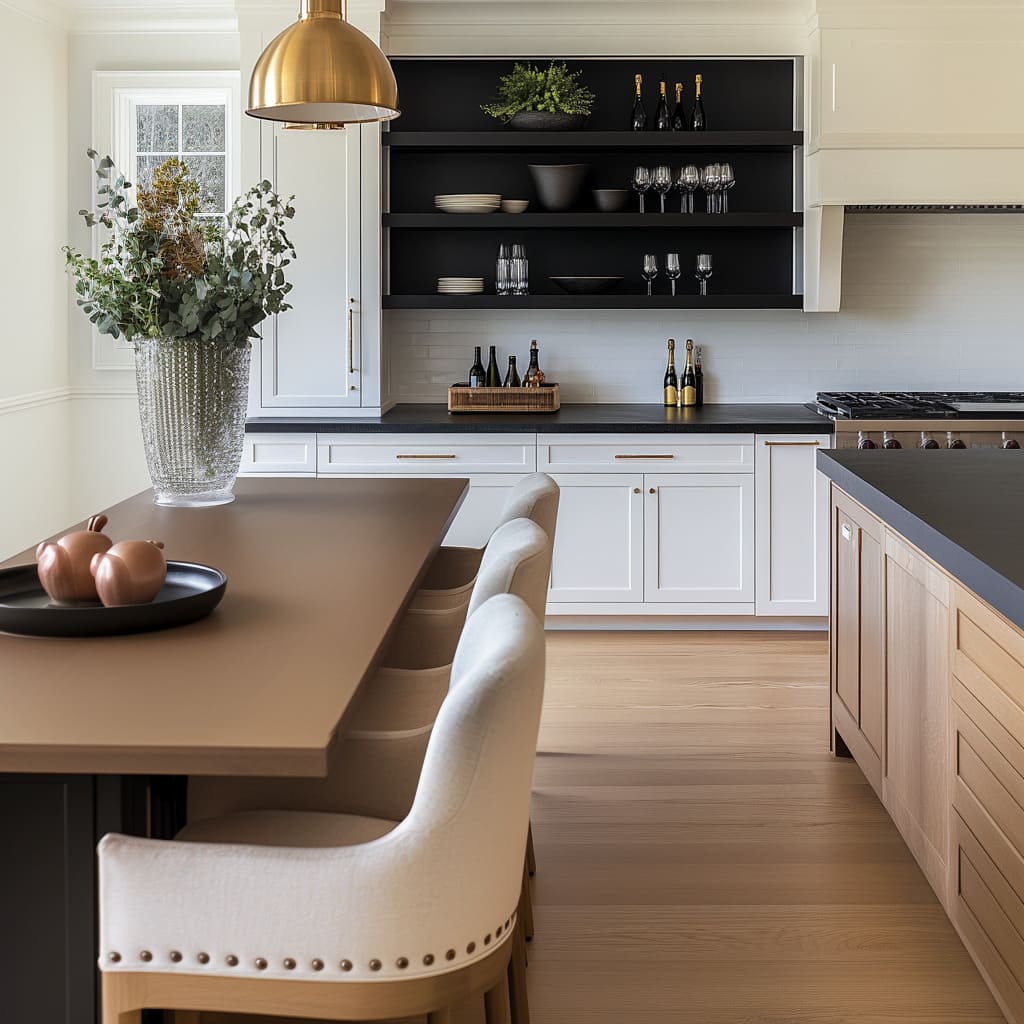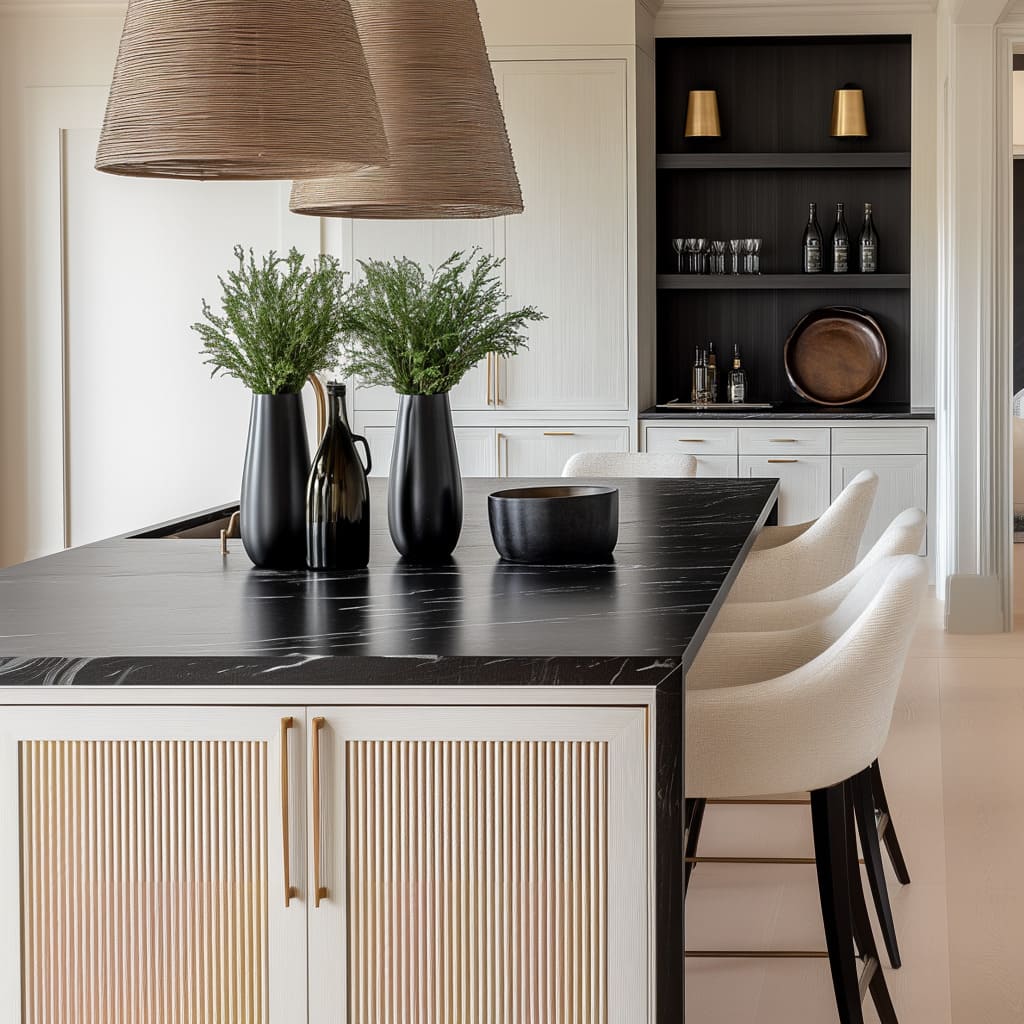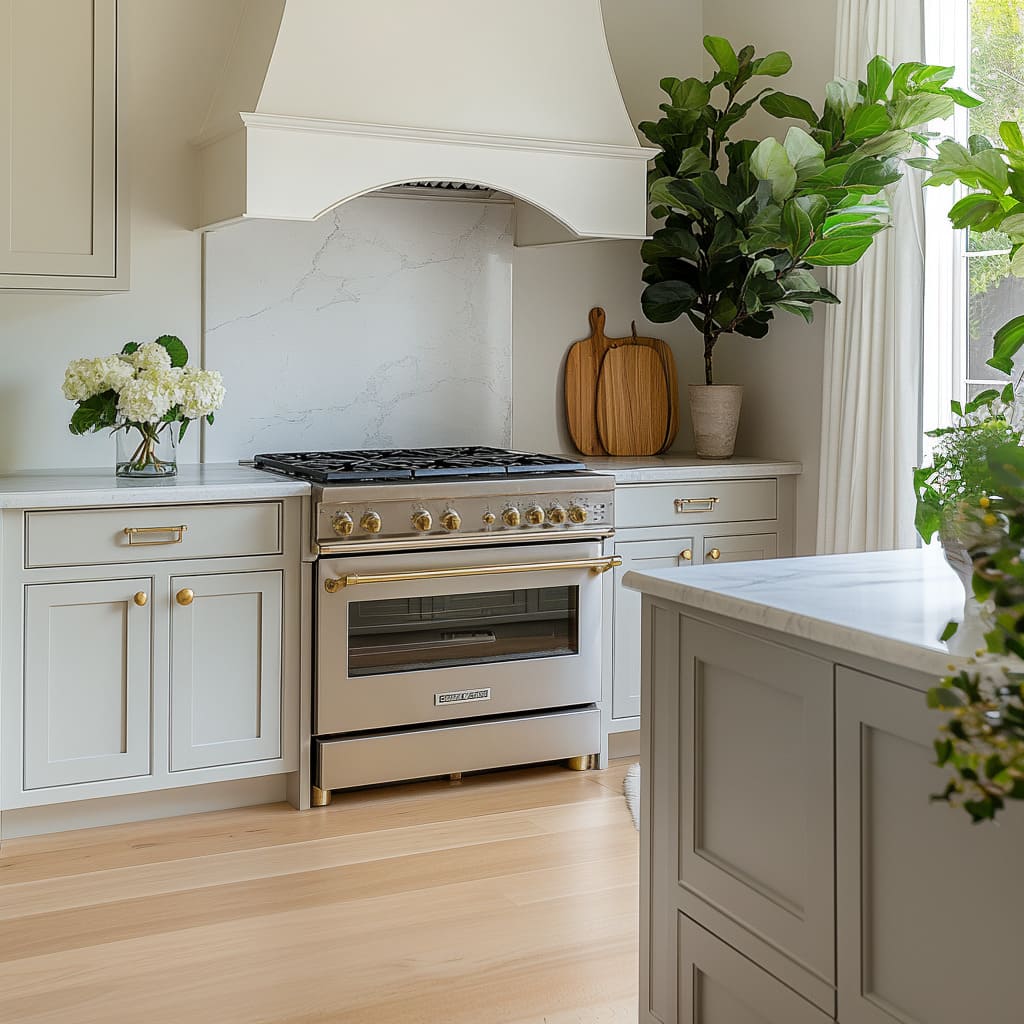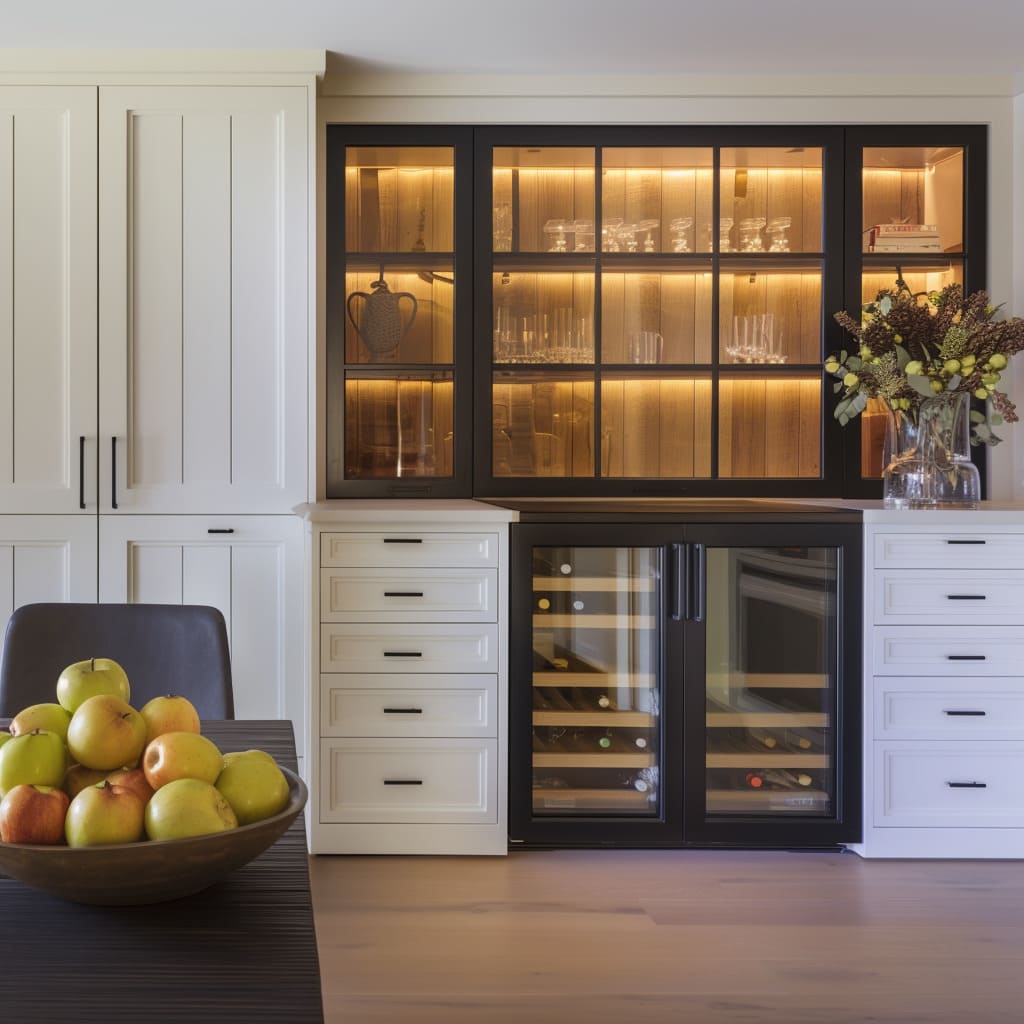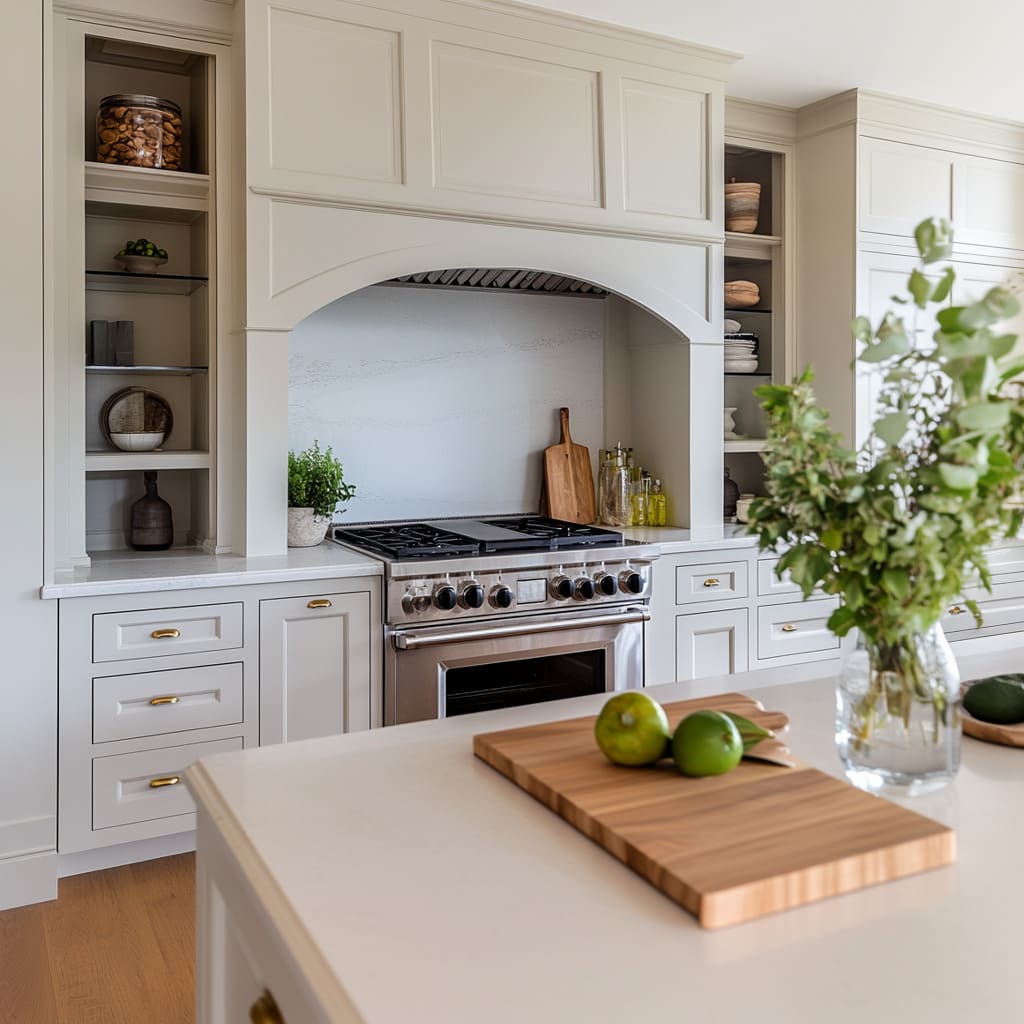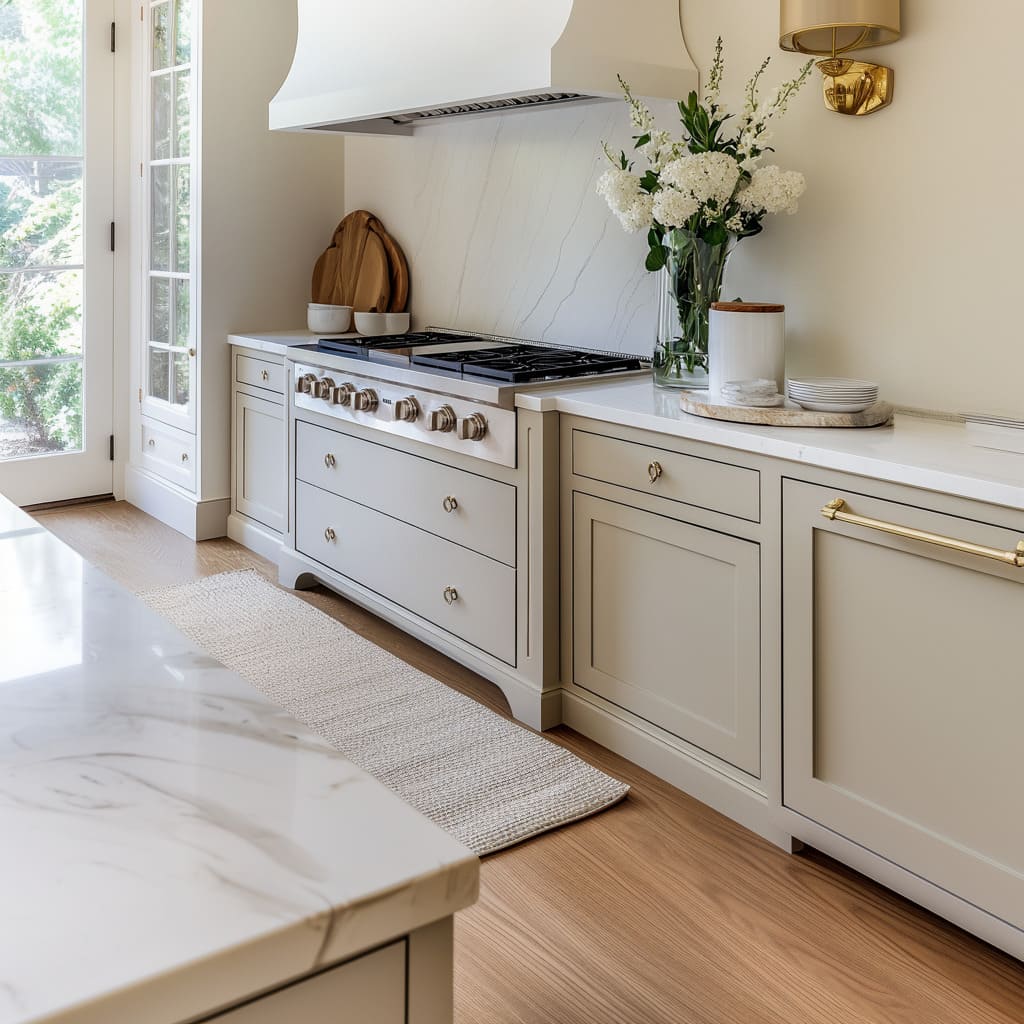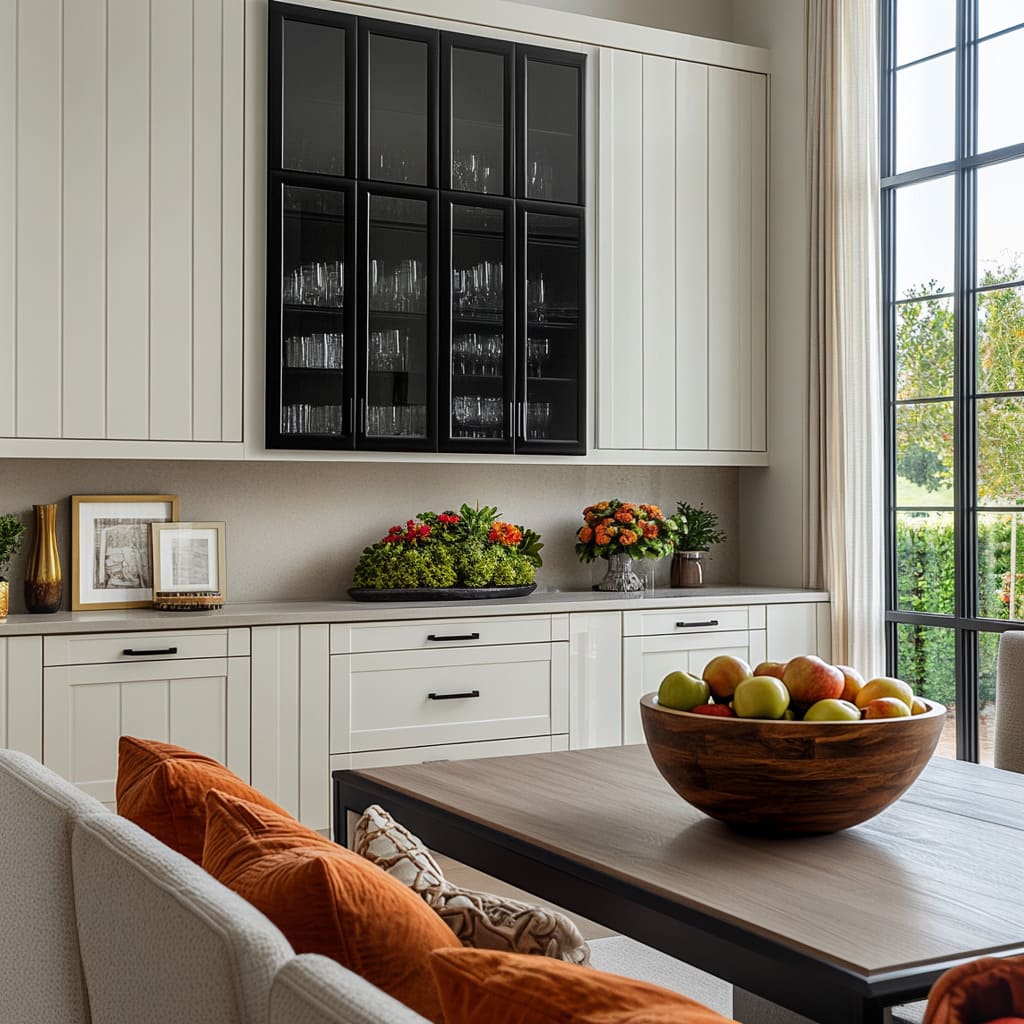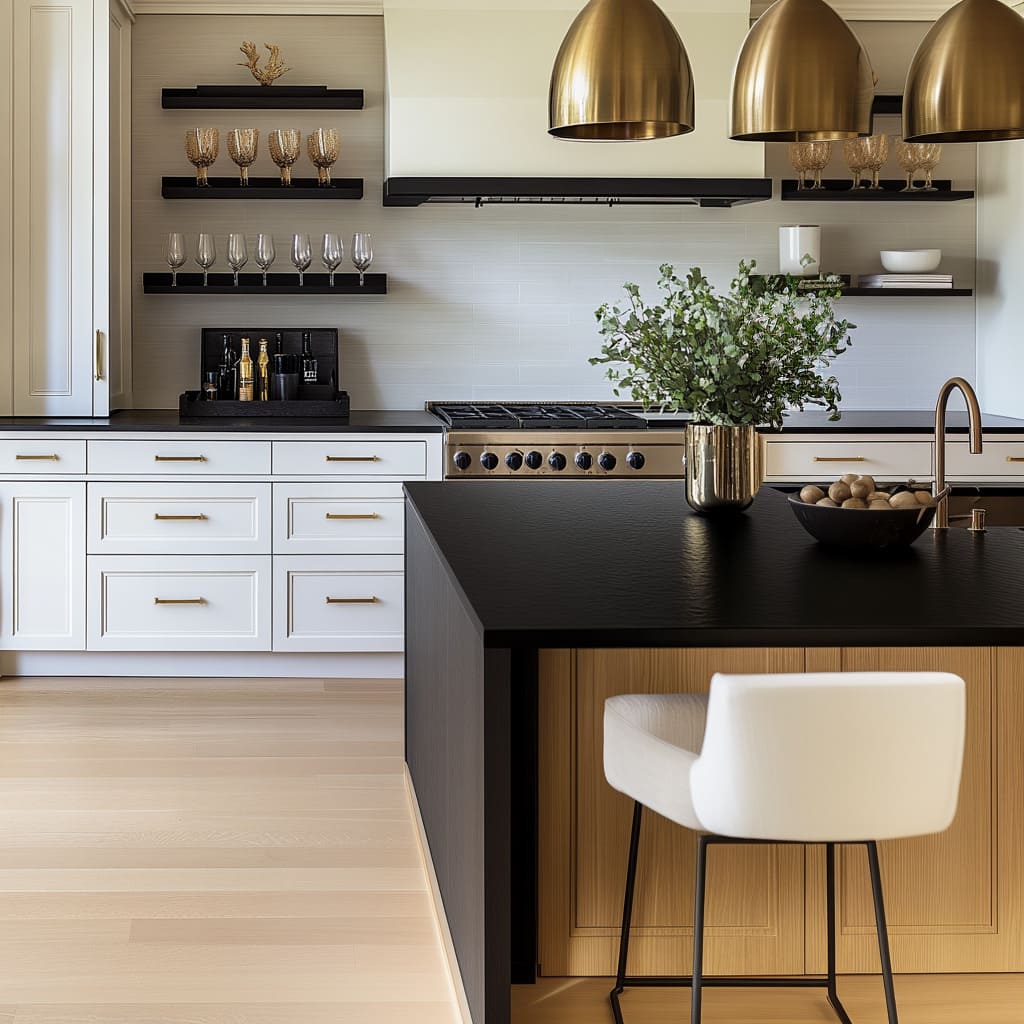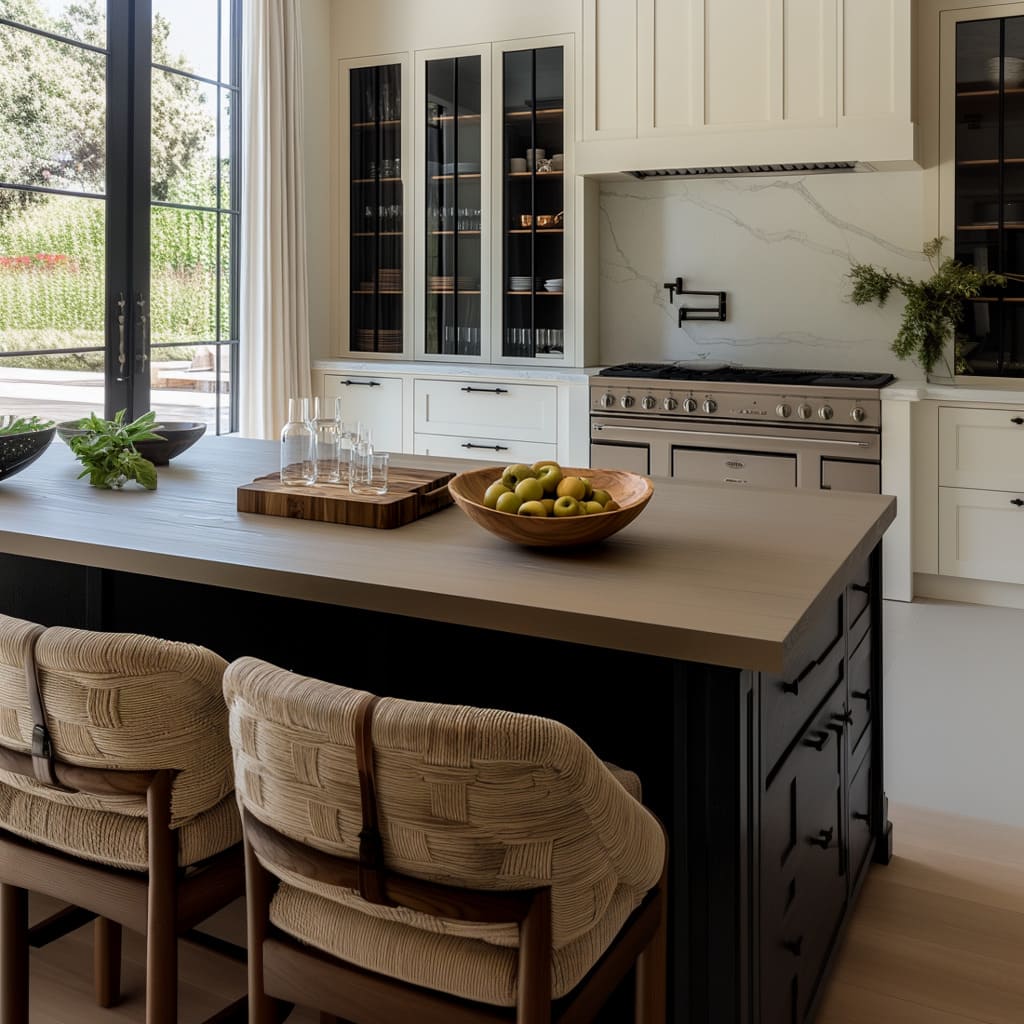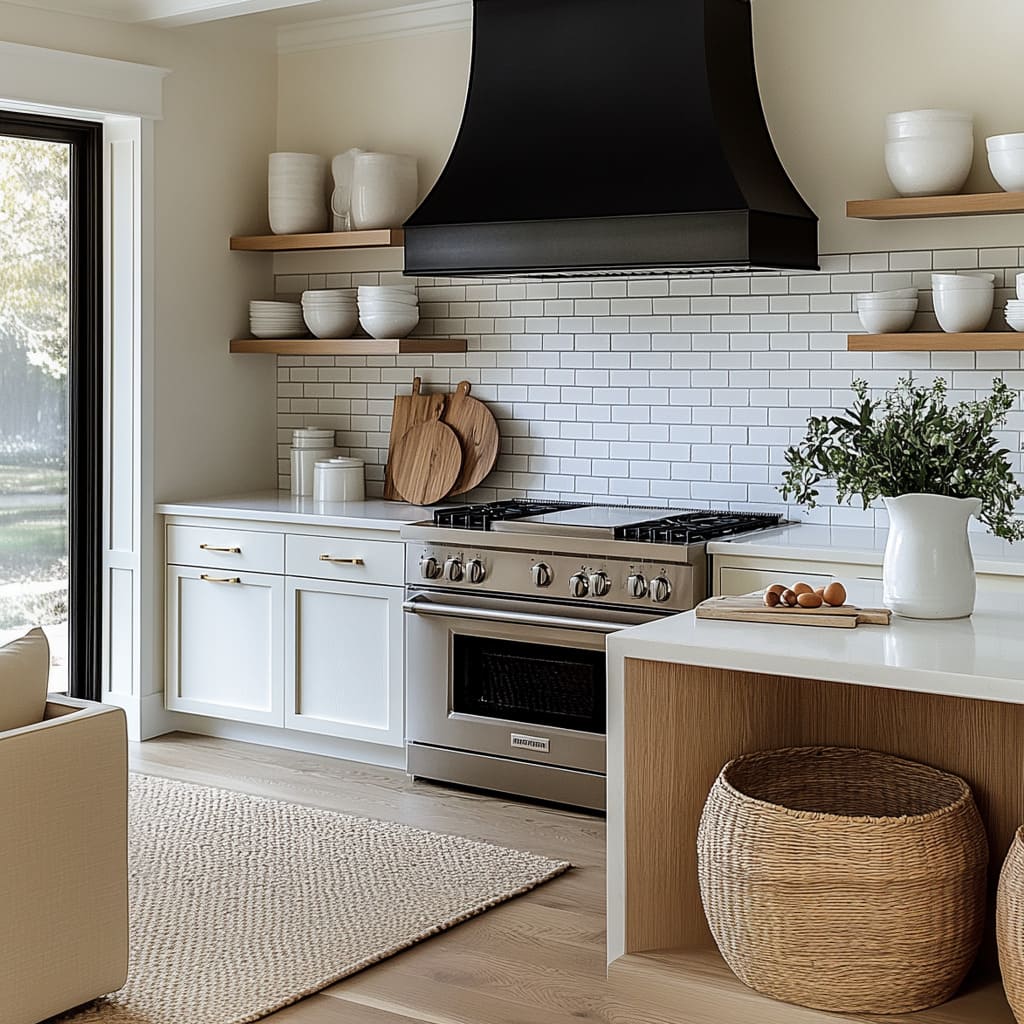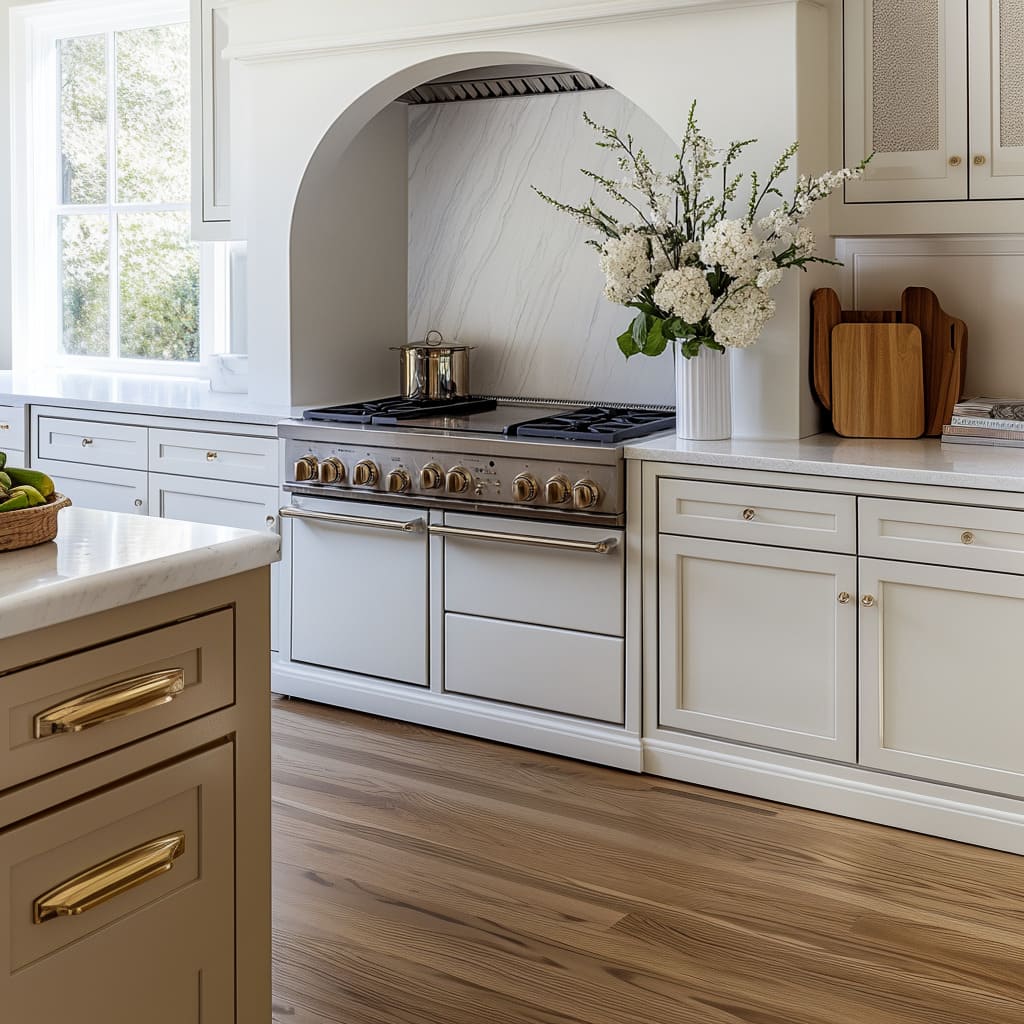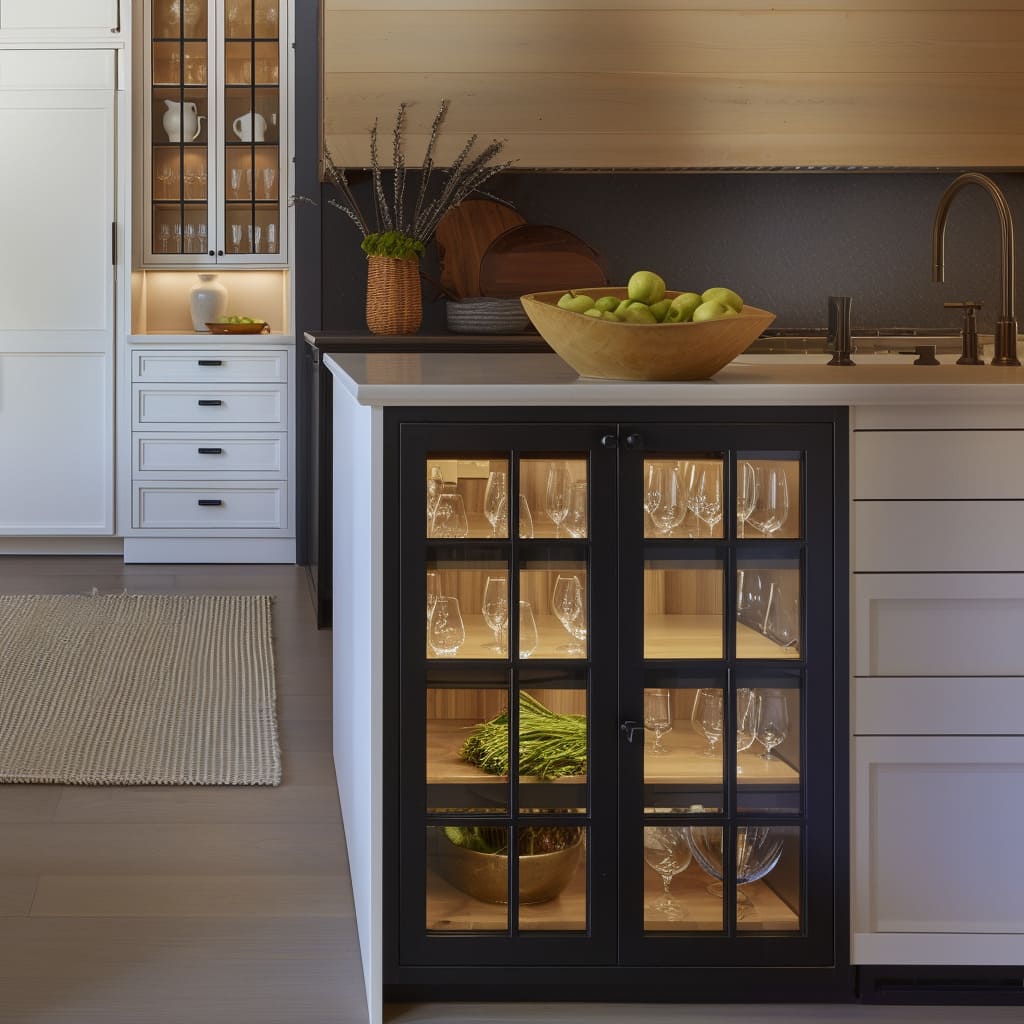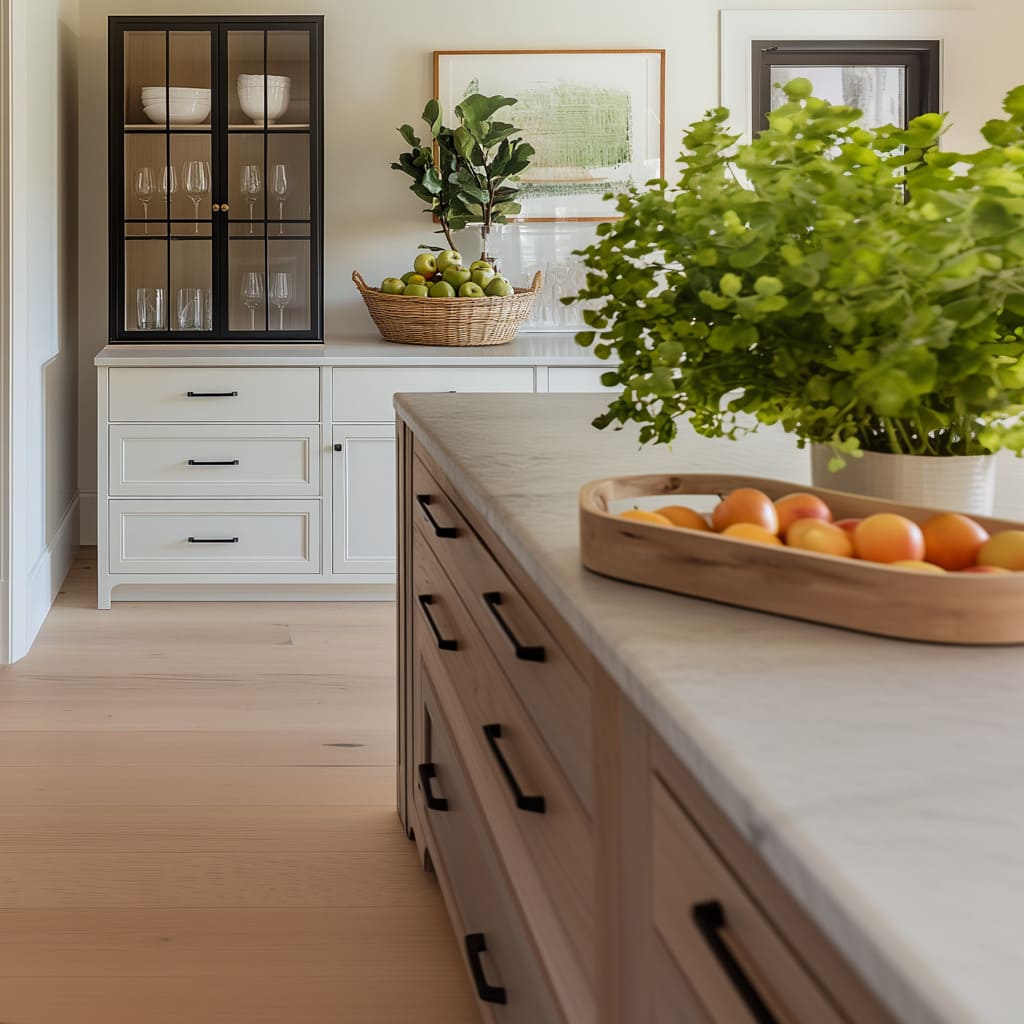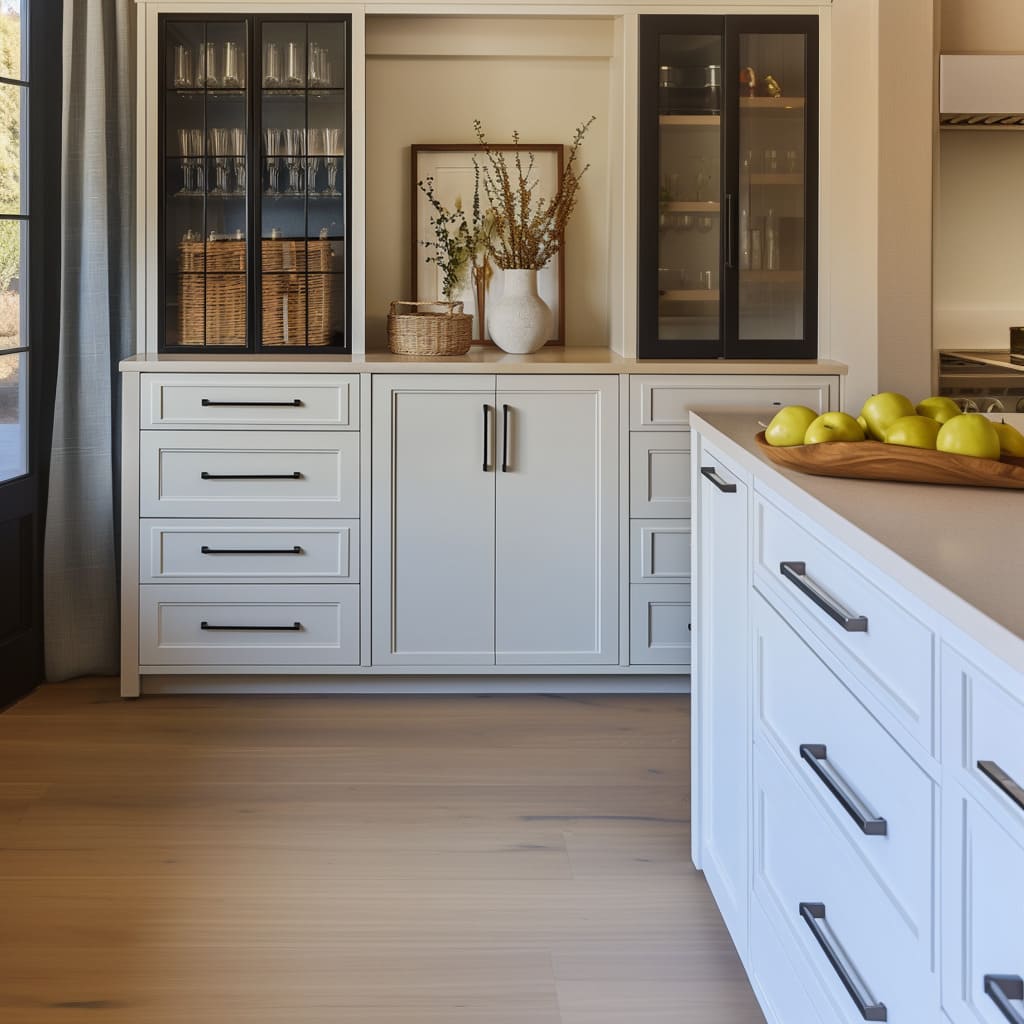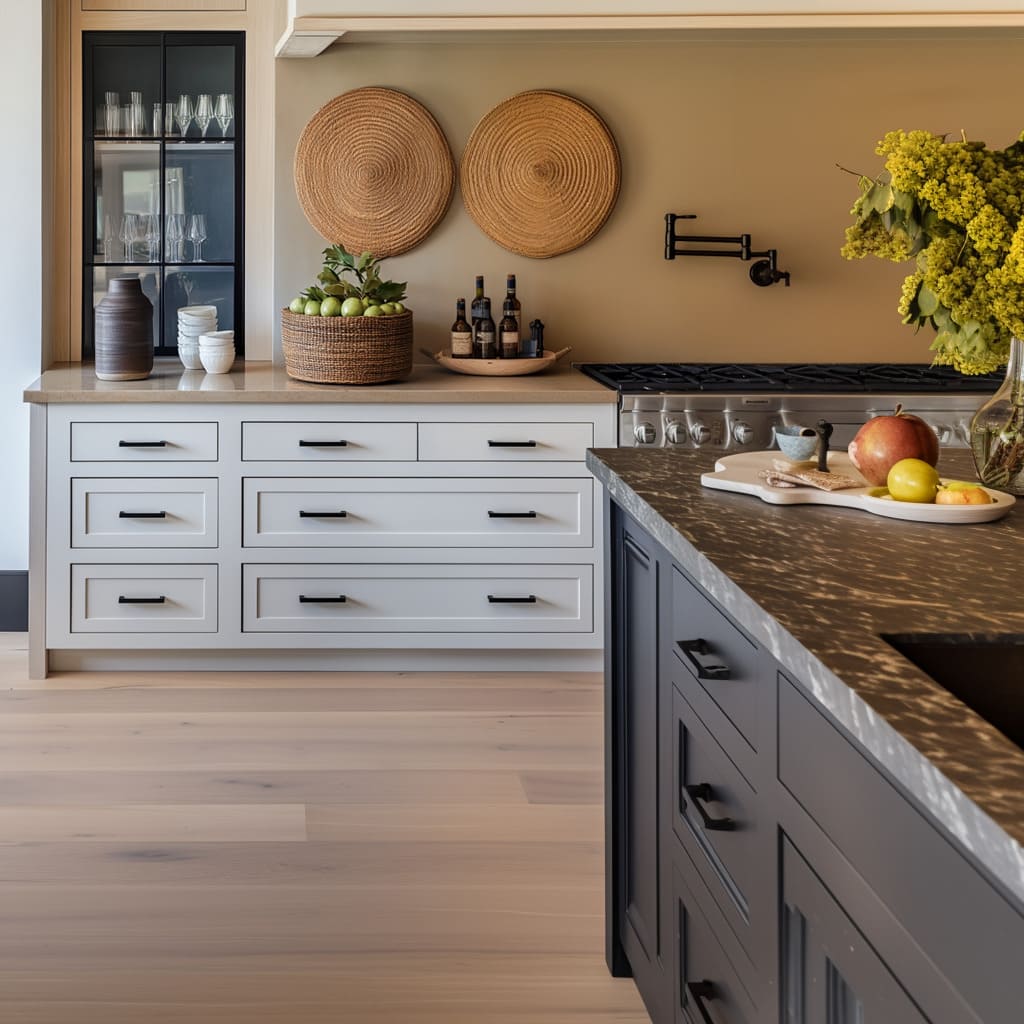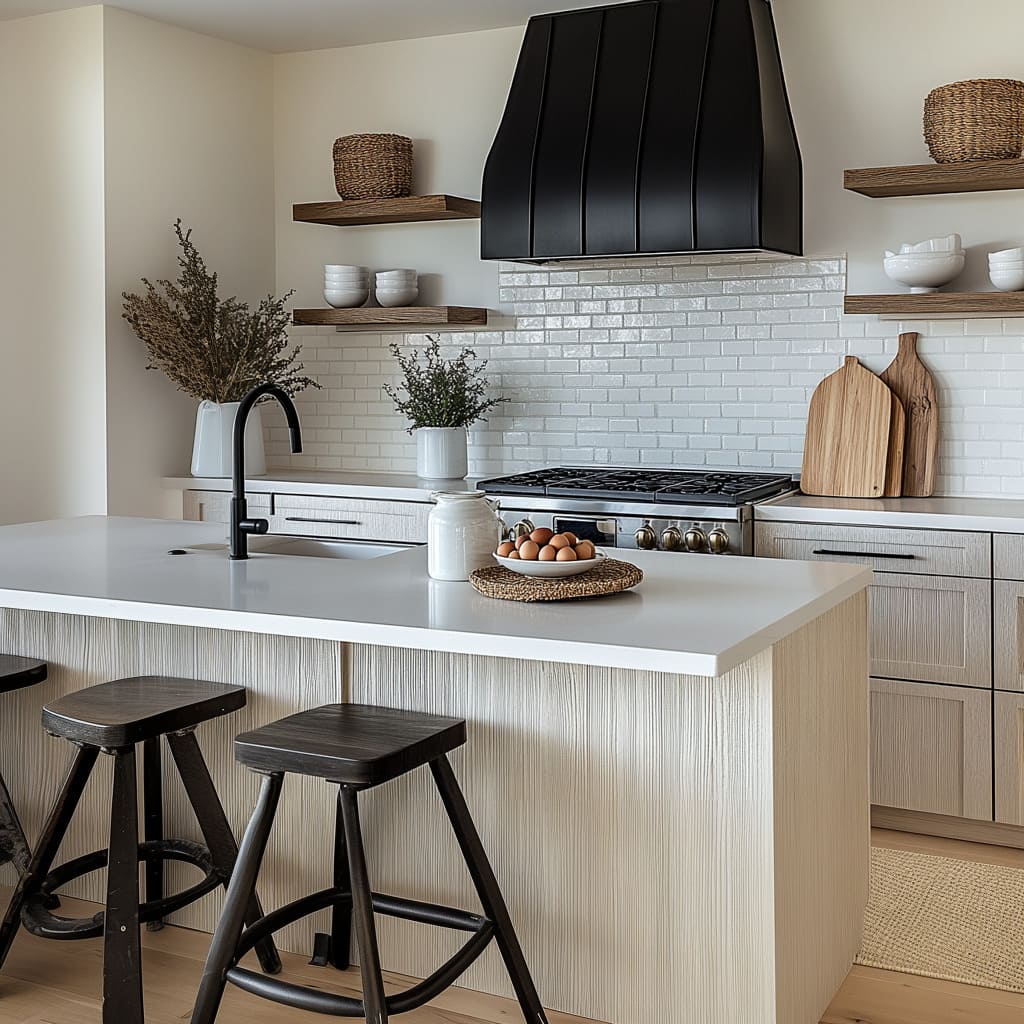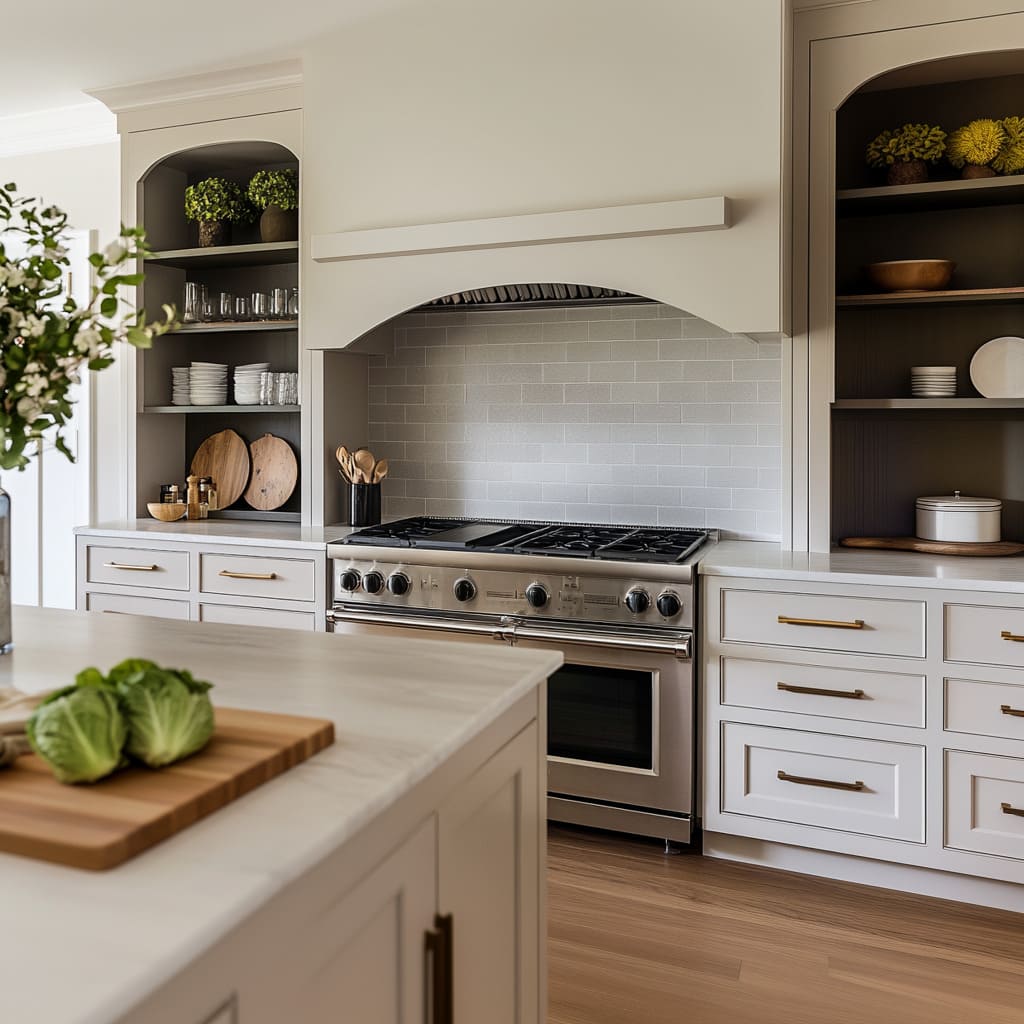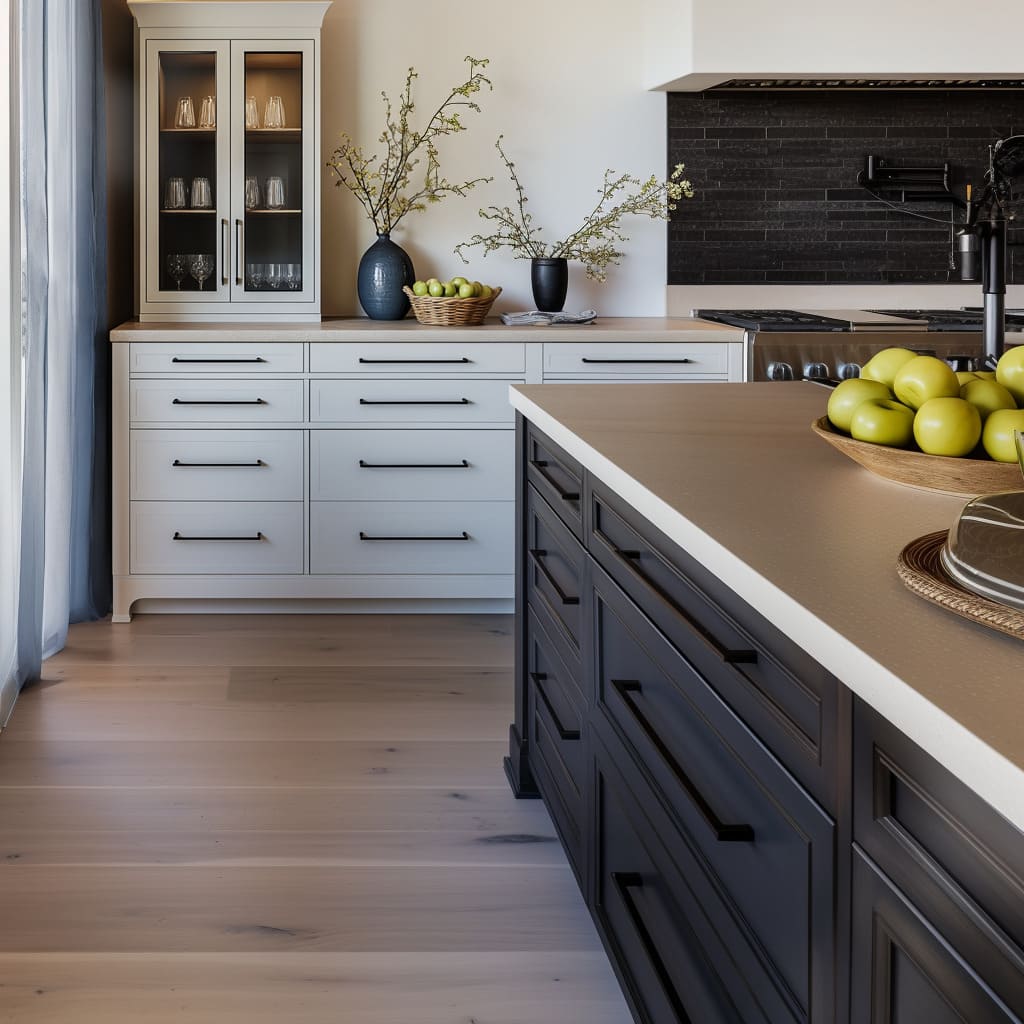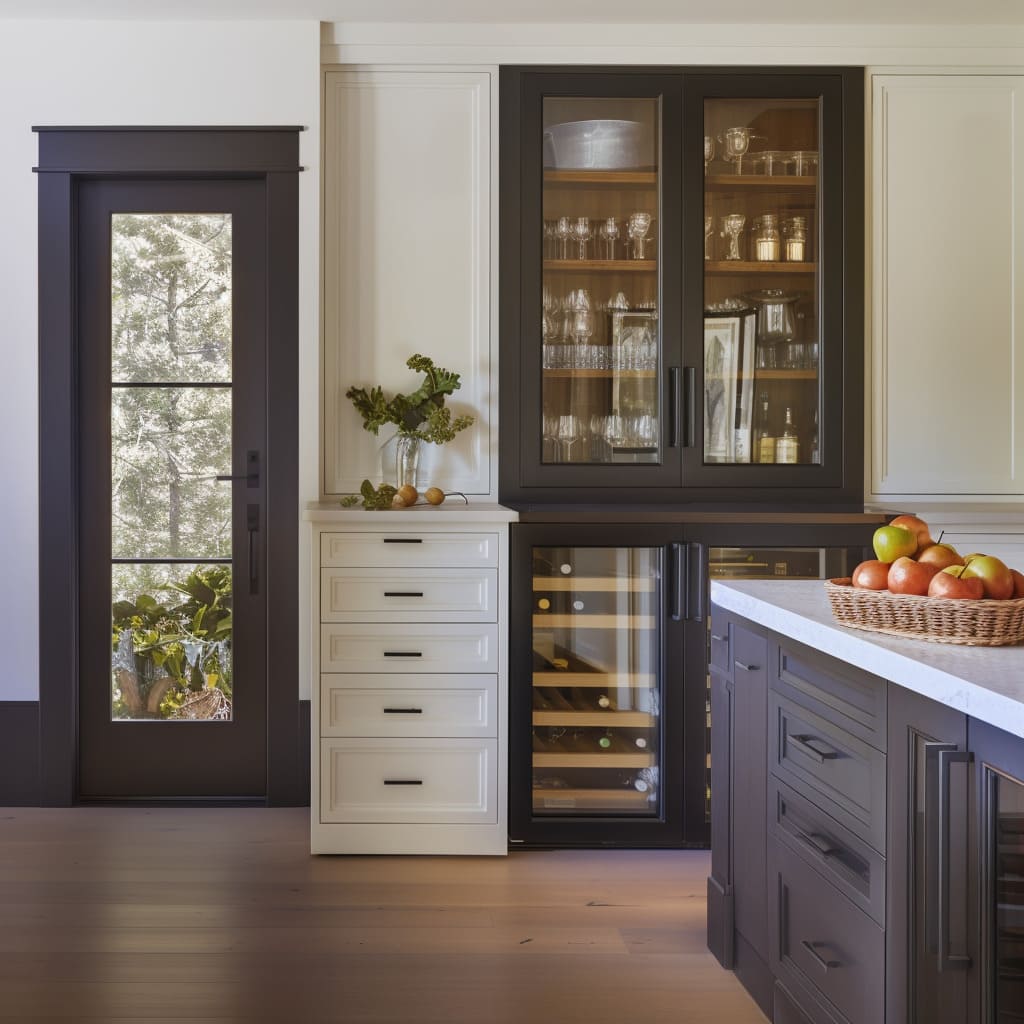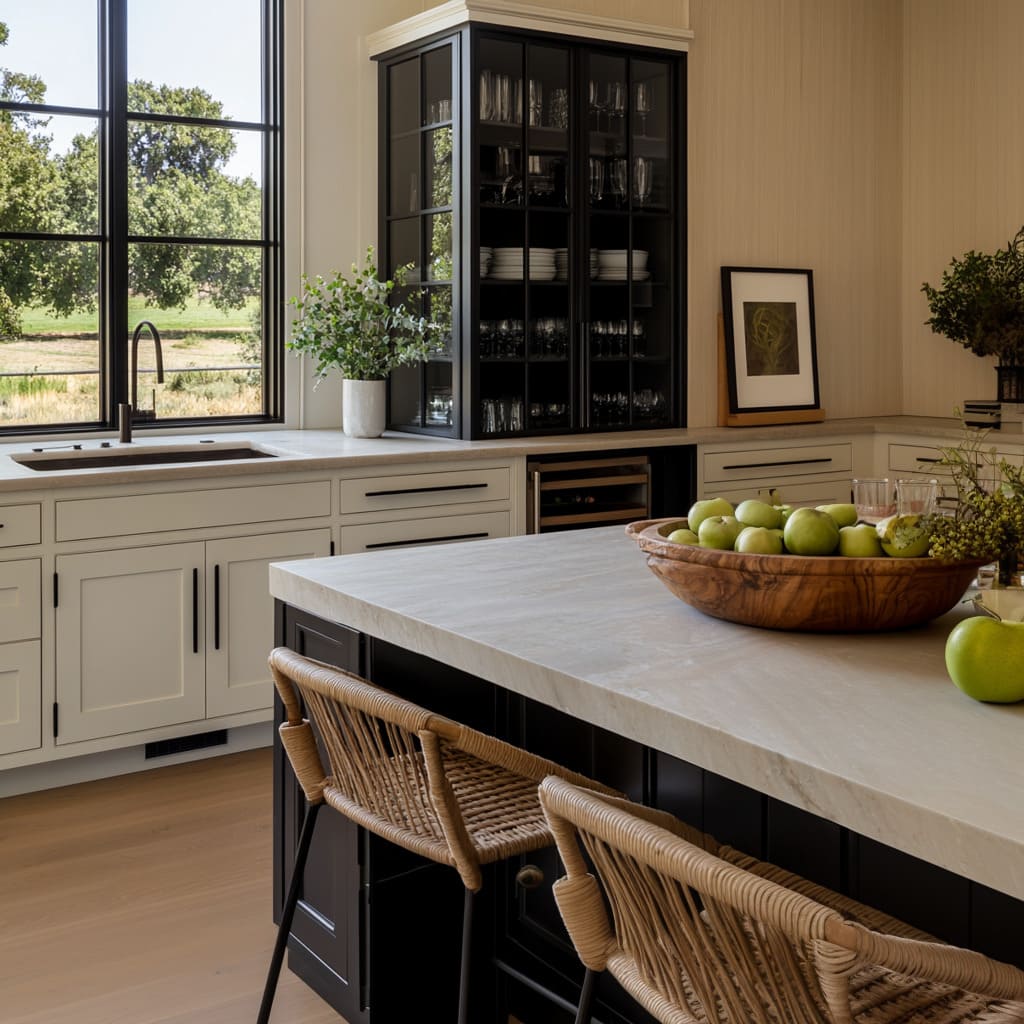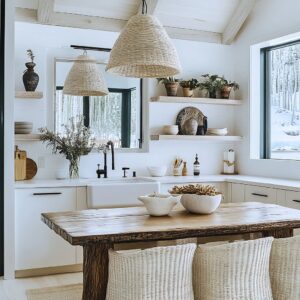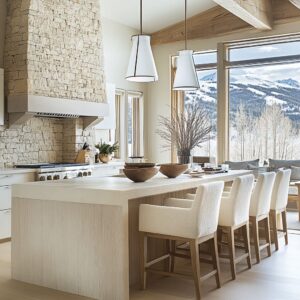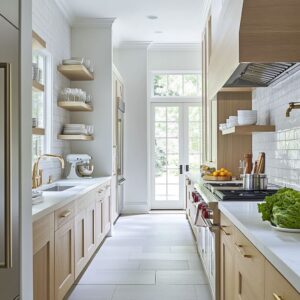A standout kitchen doesn’t rely on one show-stopping element—it’s a thoughtful mix of smart design choices, a balanced layout, and subtle contrasts that turn an everyday room into a space worth admiring. From carefully chosen materials to the play between traditional and modern styles, the latest kitchen designs strike a chord by blending functionality with character.
So, what exactly makes a kitchen catch your eye while feeling perfectly livable? Let’s dig into the details.
Style and Influence Combinations
Kitchens today are no longer defined by a single style—they are a mix of carefully curated elements that balance tradition with modernity, bold contrasts with subtle details, and functionality with aesthetics. This creative blend results in spaces that feel fresh, thoughtful, and timeless.
By understanding the most impactful influences and style trends, we can uncover how modern kitchens achieve such seamless balance.
Trendy Styles
- Modern Farmhouse has become a staple in contemporary kitchen design. It marries simplicity with comfort, offering a perfect mix of clean lines and natural, inviting textures. Think warm wooden finishes, woven chairs at the island, and the soft touch of decorative baskets on countertops or shelves. This style uses light, neutral palettes—creams, soft whites, and natural wood tones—to ensure the space feels open and cozy at the same time. To ground the warmth, subtle modern touches like matte black fixtures and sleek cabinet hardware give the design just the right edge without disrupting its welcoming vibe.
- Transitional Style is another design favorite, blending the best of both traditional and modern kitchens. It embraces classic Shaker-style cabinetry with simple paneling that feels timeless yet understated. The design leans on clean lines and minimal clutter, while adding standout features like black-framed glass cabinets, brushed gold handles, and modern light fixtures to introduce character. The magic of transitional style lies in its ability to combine these elements without leaning too far in one direction, keeping the space feeling balanced and versatile.
- Contemporary Elements add a striking layer of contrast and refinement. Kitchens that incorporate modern touches rely on bold statements, such as pairing a black island base with light-toned cabinetry. Flat-panel cabinets and matte finishes keep the design minimal, while hidden storage solutions ensure that form doesn’t come at the cost of function. These kitchens often feature backlit shelving, dark countertops, and seamless surfaces that highlight clean simplicity and understated sophistication.
- Luxury Touches elevate kitchens from ordinary to extraordinary, adding polished refinement and thoughtful details. Backlit glass cabinets act as subtle focal points that softly illuminate the space, particularly in the evenings. High-quality stone countertops—like marble or quartz—become statement surfaces that feel luxurious without overpowering the design. Wine coolers or built-in glass shelving bring a sense of exclusivity, often blending function and display. This touch of indulgence creates kitchens that feel as sophisticated as they are practical.
Trends in Style Combinations
The fusion of Farmhouse Meets Modern is one of the most notable trends in today’s kitchen designs. By integrating soft, organic elements—like wicker textures, wooden accents, and fresh greenery—into a sleek, modern layout, designers create spaces that feel both grounded and refined.
A perfect example might include new contemporary kitchen cabinets with clean black framing paired alongside warm, natural wood countertops or open shelving. This approach softens modern design’s sharper edges while ensuring the overall look remains clean and polished.
Bold Contrasts in Modern Transitional kitchens are where visual statements shine the brightest. Designers often use deep, moody tones like black or charcoal for the island base, which contrasts beautifully with light surrounding cabinetry.
This interplay of dark and light adds dimension, allowing the eye to travel effortlessly across the room. Flat black hardware or sleek brushed gold handles further enhance the contrast, acting as small but impactful details that tie everything together.
The Natural Organic Influence is what sets standout kitchens apart from sterile or overly modern spaces. It’s about using materials and decor that bring an element of warmth and life.
Think wooden trays holding fresh fruit, ceramic vases with leafy branches, or simple woven baskets that double as storage and decor. These textures not only soften the room but also connect it to a more relaxed, earthy aesthetic.
Combined with natural light and soft, neutral palettes, this trend ensures that modern kitchens feel as livable as they are stylish. The magic of a standout kitchen lies in the thoughtful blending of styles and trends that reflect both personality and practicality.
By combining modern farmhouse charm, transitional elegance, and contemporary simplicity, designers create spaces that offer comfort without compromising style. Add to this mix bold contrasts, natural textures, and a few refined touches, and you get kitchens that truly stand out—spaces that feel timeless, fresh, and perfectly balanced.
Cabinet Facades and Finishes
The choice of cabinet facades and finishes plays a critical role in defining the kitchen’s style. Shaker-style doors dominate many transitional kitchens, bringing a timeless charm that strikes a perfect balance between modern simplicity and classic appeal.
Their clean lines and subtle framing make them versatile, complementing both traditional farmhouse elements and sleek modern accents. Bold-colored islands are a trend that refuses to go unnoticed.
Black or deep grey cabinetry on island bases creates a striking contrast against lighter upper and surrounding cabinets. Paired with light countertops—such as quartz or marble—this bold choice grounds the kitchen, adding visual depth without making it feel heavy.
The contrast draws the eye and immediately sets the island apart as the centerpiece of the room. The popularity of matte finishes speaks to the rise of clean, minimal aesthetics in modern kitchens.
Unlike high-gloss options, matte surfaces absorb light instead of reflecting it, creating a soft, sophisticated look that feels refined yet approachable. These finishes work particularly well with both neutral and dark color palettes, further contributing to a kitchen’s understated elegance.
Insights into Cabinetry Design
A key design insight seen across kitchens is the intentional use of contrast to add dimension and character. Black-framed glass cabinets, dark island bases, and lighter upper cabinetry work together to strike a delicate balance—grounding the room while maintaining an airy feel.
This contrast ensures that the space doesn’t feel flat or one-note, instead offering depth that draws the eye naturally across the design. Glass-front cabinets emerge as more than just storage—they’re a design feature that transforms kitchens into showcases.
When backlit, these cabinets become even more impactful, casting a warm glow that highlights curated displays and adds a subtle layer of sophistication to the room. Lastly, handles and hardware prove that even the smallest details can make a big difference.
Black or gold handles are consistently used to complement Shaker-style and flat-panel cabinets. The choice of matte black hardware adds modern contrast, while brushed gold brings a soft, luxurious touch.
These elements enhance the cabinetry without overpowering it, acting as subtle accents that tie the overall design together seamlessly. Modern kitchens excel by making cabinetry a central focus of both form and function.
From Shaker-style facades to bold island contrasts and glass-front focal points, every detail contributes to a space that’s practical, beautiful, and cohesive. By integrating clever storage solutions and embracing finishes like matte surfaces or bold tones, new kitchen ideas redefine how cabinetry can elevate the entire design, creating kitchens that feel as organized as they are visually striking.
Countertops and Finishes
Countertops are the unsung heroes of kitchen design, acting as functional surfaces while tying together the overall aesthetic. The materials, finishes, and styling of countertops can transform a kitchen from ordinary to exceptional.
In modern kitchens, the latest trends in kitchen countertops focus on clean simplicity, natural tones, and a seamless connection to the cabinetry and decor.
Common Countertop Materials
Light-toned stone surfaces dominate in many kitchens, with materials like quartz and marble standing out as favorites. Their soft, neutral palettes—ranging from cool whites to subtle greys—reflect natural light beautifully, brightening the space and complementing surrounding cabinetry.
Quartz is often chosen for its durability and consistency, while marble adds a more natural, organic touch with its soft veining and unique patterns. These choices enhance the kitchen’s elegance while offering practical benefits for daily use.
Smooth, matte finishes are another recurring trend. Unlike glossy counters that reflect light, matte surfaces provide a softer, more understated look.
They pair exceptionally well with textured decor elements, such as wooden trays, woven bowls, and natural greenery, creating a balanced contrast that feels both refined and relaxed. The clean finish of matte counters also works seamlessly with contemporary kitchen units, where simplicity and minimalism are key design principles.
Islands, which often act as a visual centerpiece in modern kitchens, frequently feature extended countertops with overhangs to accommodate bar seating. This practical extension creates a casual dining space while maintaining a polished look.
Whether paired with woven stools or sleek chairs, the overhang adds a functional layer without disrupting the kitchen’s clean lines.
Not-Trivial Combinations
One of the most impactful countertop trends involves bold islands paired with light counters. A dark island base—painted black, charcoal, or deep grey—grounded by a soft, light-toned countertop creates a striking focal point.
This contrast draws the eye to the island as the heart of the kitchen while ensuring the room feels spacious and airy. The light surface reflects natural light, balancing out the island’s depth and creating harmony with surrounding cabinetry.
To keep counters feeling warm and inviting, designers often incorporate organic decor. Wooden trays, ceramic bowls filled with fruit, or simple textured accents are common additions.
These natural elements soften the sleek, polished look of stone surfaces and add visual interest. For example, a smooth quartz countertop can be instantly elevated with a wooden bowl of green apples or a woven basket with fresh herbs.
This blend of organic and polished materials prevents the space from feeling overly sterile while maintaining its clean aesthetic. Another clever design approach is the seamless integration of counters and backsplashes.
Extending the countertop material into the backsplash creates a sense of visual continuity, which is particularly impactful in modern kitchens. This technique eliminates the need for contrasting backsplash tiles, resulting in a sleek, streamlined look that enhances the room’s overall flow.
For kitchens with minimal upper cabinetry, this design choice further emphasizes the open, airy feel of the space. Today’s countertop trends combine beauty and practicality, offering surfaces that enhance the kitchen’s aesthetic while standing up to everyday use.
The focus on light-toned stone, matte finishes, and functional extensions reflects a growing preference for clean, uncluttered spaces that still feel warm and livable. By incorporating bold contrasts, natural accents, and seamless integrations, these kitchens demonstrate how thoughtful design can bring both style and functionality to life.
Whether working with an island centerpiece or tying counters to contemporary kitchen units, every detail contributes to a cohesive and inviting space.
Flooring and Ceiling Finishes
Flooring and ceiling choices play a subtle but essential role in bringing kitchens together, creating flow and defining the atmosphere of the space. While cabinets and countertops often take center stage, these foundational elements provide the backdrop that makes every other detail shine.
In the latest kitchen styles, designers have embraced flooring and ceiling finishes that unify, highlight, and balance the overall aesthetic.
Flooring Trends
Light natural hardwood continues to dominate modern and transitional kitchens, offering warmth and neutrality that effortlessly ties the room together. Soft oak or maple tones bring an organic quality to the space, balancing out the sleek lines of contemporary cabinets and polished stone countertops.
These light wood floors are particularly effective in kitchens that embrace farmhouse or organic modern styles, where natural materials are key to softening sharper elements like black-framed glass cabinets or matte-finished counters. Another standout feature is visual continuity.
In many designs, the flooring extends seamlessly across the entire kitchen and into adjacent spaces, creating a smooth flow between rooms. This strategy enhances the sense of openness, especially in open-concept homes where the kitchen blends into living and dining areas.
Light wood tones reflect natural light beautifully, amplifying the feeling of spaciousness without overpowering the design. By acting as a neutral base, the flooring allows statement features—like bold islands or decorative range hoods—to take the spotlight while maintaining balance in the space.
Practicality also plays a key role in modern flooring trends. Beyond their visual appeal, light hardwoods are durable, easy to maintain, and timeless.
They adapt well to evolving decor styles, ensuring the space feels cohesive even as trends shift. When paired with textured rugs, they provide an additional layer of warmth and softness, enhancing the kitchen’s overall comfort and usability.
Ceiling Features
Ceilings in modern kitchens lean toward neutral and minimal finishes, often painted in soft white or cream tones. This simplicity serves two purposes: it enhances light reflection, making the space feel brighter, and it provides a clean, unobtrusive backdrop that lets other design elements stand out.
Minimal ceilings are particularly effective in kitchens with tall cabinetry or large windows, where the focus naturally shifts toward vertical features and the surrounding views. Custom range hoods have emerged as statement pieces that seamlessly integrate with ceiling lines, acting as visual anchors in the kitchen.
Whether designed with subtle arches, clean minimalist shapes, or intricate detailing, these range hoods connect upper cabinetry to the ceiling, creating a sense of unity. They draw the eye upward, breaking the monotony of an otherwise plain ceiling while reinforcing the overall style of the kitchen.
In kitchens that embrace transitional or farmhouse styles, range hoods often feature soft curves or subtle paneling that echoes the cabinetry design. In contrast, more contemporary spaces lean toward sleek, angular shapes that align perfectly with modern cabinets and matte finishes.
Regardless of style, the range hood serves as a central focal point, grounding the space and enhancing its architectural appeal. Flooring and ceiling finishes may not be the first details noticed in a kitchen, but they are vital for achieving a cohesive, balanced design.
Light hardwood floors set the stage for modern and farmhouse-inspired kitchens, offering warmth, practicality, and flow. Meanwhile, neutral ceilings and custom range hoods add subtle elegance and visual balance, uniting cabinetry, countertops, and surrounding features.
Together, these elements ensure that the kitchen feels complete—proving that even the simplest finishes can have a significant impact when thoughtfully chosen.
Decorative Elements and Small Decor Ideas
When it comes to creating a kitchen that feels inviting and lived-in without overwhelming the space, the right decorative elements can make all the difference. Whether introducing texture, color, or natural forms, subtle details elevate the kitchen’s personality.
Modern kitchens are seeing a shift toward organic, functional, and curated decor that enhances both the style and usability of the space.
Key Decorative Trends
Organic and Natural Materials have become a hallmark of contemporary kitchens, striking the perfect balance between warmth and modern minimalism. Wooden cutting boards and trays are a go-to choice, adding texture and a sense of craftsmanship to sleek, matte countertops or polished stone.
Similarly, wooden bowls act as statement pieces on islands or countertops, tying in natural tones from the flooring and cabinetry. Woven baskets stand out as versatile decor elements that bridge farmhouse and modern styles.
Whether displayed on countertops, tucked into shelves, or even hung as wall decor, they bring texture and depth to an otherwise clean and linear kitchen design. This technique works particularly well in kitchens with a transitional influence, where layers of natural materials soften contemporary lines.
Greenery is another essential component of today’s decorative trends. Potted plants and branches arranged in tall vases break up neutral color schemes while bringing a touch of nature indoors.
These organic forms introduce a dynamic element, particularly when placed on islands or countertops, where they contrast with clean surfaces. The key lies in simplicity: a tall glass vase with a few large branches or a small pot of herbs can instantly add life without cluttering the space.
Curated Displays and Layering
Curated displays inside glass-front cabinets are a clever way to introduce style and personality. Instead of using cabinets solely for functional storage, homeowners are showcasing decorative items like glassware, ceramic dishes, or minimalist pottery.
These displays often benefit from subtle lighting—such as under-shelf or backlit options—that highlight the items and draw visual interest without feeling too “styled. ” In modern kitchens, these elements transform practical storage into contemporary kitchen decor ideas.
Subtle layering through small decorative accents creates depth and interest while maintaining a clean, organized feel. Fruit bowls remain a classic choice, introducing soft pops of color like greens, reds, and yellows.
Placed on islands or countertops, they create a focal point while maintaining a natural, effortless look. Wooden trays are often used to corral functional items like cutting boards, salt and pepper mills, or utensils, creating a styled yet purposeful arrangement.
Baskets—whether large and woven or smaller and decorative—add an extra layer of texture. Used on shelves, floors, or tucked into cabinetry, they provide storage while enhancing the kitchen’s organic aesthetic.
Similarly, tall vases with branches act as a subtle but impactful design choice. Their height contrasts with lower cabinetry and countertops, balancing horizontal lines and adding a hint of drama to the space.
Decorative elements play an integral role in modern kitchens by combining functionality with thoughtful design. Natural materials like wood and woven textures add warmth and dimension, softening clean lines and matte finishes.
Greenery, layered decor, and curated displays reflect a shift toward intentional styling that feels lived-in yet polished. By incorporating these small but significant details, today’s kitchens achieve a harmonious blend of style and function, creating spaces that feel both practical and personal.
Lighting as a Functional and Design Element
Lighting is one of the most defining elements in kitchen design, not only for its functional purpose but for its ability to highlight, balance, and transform the space. A well-thought-out lighting plan can amplify the beauty of cabinets, countertops, and decor while keeping the kitchen practical for day-to-day tasks.
From large windows to layered artificial lights, lighting choices in modern kitchens are as much about form as they are about function.
Types of Lighting
Natural Light remains the foundation of many beautifully designed kitchens. Large windows, expansive glass doors, and open layouts allow sunlight to stream through, creating a bright and inviting atmosphere.
Natural light enhances the clean tones of cabinetry and countertops, while its shifting intensity throughout the day adds depth and movement to the room. Kitchens with light-toned hardwood floors and white or cream cabinetry particularly benefit from sunlight, as these elements reflect and amplify brightness.
Backlit Cabinets introduce an ambient glow that is both decorative and functional. This lighting style is particularly effective in kitchens with glass-front cabinets, where internal lights showcase curated displays of glassware or ceramics.
The soft backlighting draws attention to these features without being overwhelming, adding subtle luxury to the overall design. It works exceptionally well in transitional kitchens, where decorative elements are thoughtfully incorporated into a modern setting.
Task Lighting, though less visible, is essential for functionality. Subtle under-cabinet lights illuminate countertops, ensuring that meal preparation and other tasks are performed with ease.
These fixtures are designed to blend seamlessly into the cabinetry, maintaining the kitchen’s visual harmony while providing targeted lighting where it’s needed most. Islands often incorporate similar solutions with subtle overhead lights that focus on work zones without distracting from the space’s aesthetic.
Finally, layered light sources ensure a well-rounded lighting plan. Natural light is supported by ambient fixtures like pendant lights, recessed lighting, and backlit elements, maintaining balance as daylight shifts.
This combination ensures that the kitchen remains functional, comfortable, and visually pleasing throughout the day and into the evening.
Insights on Lighting Balance
Thoughtful lighting design creates a sense of balance that enhances the kitchen’s overall aesthetic. One clever approach is highlighting focal points using internal or backlit cabinet lighting.
Glass-front cabinets benefit the most, as soft backlighting draws attention to their carefully arranged displays, turning functional storage into a decorative feature. This method adds sophistication while subtly elevating the room’s ambiance.
Another notable technique is dark and light harmony. Kitchens with bold cabinetry, particularly black islands or black-framed glass cabinets, naturally absorb some of the brightness from natural light.
This prevents the space from feeling overly stark or sterile, creating a more visually comfortable atmosphere. The interplay between dark and light elements ensures balance, with lighting playing a central role in tying the room together.
For anyone seeking inspiration, new kitchen lighting ideas continue to emphasize subtle elegance and layered functionality. Whether it’s the soft glow of a backlit cabinet, natural light flooding through large glass windows, or under-cabinet lighting that brings focus to task zones, lighting choices shape how a kitchen looks and feels.
Lighting serves as both a practical necessity and a design tool in modern kitchens. Natural light creates openness, while layered fixtures like backlit cabinets and under-cabinet task lighting enhance functionality and beauty.
By highlighting key focal points and balancing dark and light elements, today’s kitchens achieve a harmonious glow that feels both welcoming and refined. Thoughtfully chosen lighting transforms a kitchen into a space where form and function work seamlessly together.
Layout and Functionality
The layout of a kitchen is where style meets purpose, turning a beautiful space into one that works seamlessly for daily life. A well-designed kitchen layout balances aesthetics, usability, and flow, ensuring that every inch of the room serves a purpose.
In the latest kitchen trends, the emphasis is on creating spaces that adapt to both cooking and socializing while maintaining visual harmony. Whether it’s through islands that multitask or smart storage solutions, functionality has become just as essential as style.
Common Layout Features
Islands as Multitaskers have become a staple in modern kitchen layouts, and for good reason. They bring together prep space, dining options, and storage all in one central location.
Islands often feature deep drawers for utensils, hidden compartments for appliances, and extended countertops that double as breakfast bars. This versatility transforms the island into the heart of the kitchen—whether you’re chopping vegetables, grabbing a quick meal, or hosting friends for coffee.
Defined work zones ensure the kitchen functions as efficiently as possible. Cooking areas typically feature prominent range hoods, which are flanked by built-in cabinetry or open shelving.
This setup isn’t just practical; it also creates a natural focal point that enhances the kitchen’s overall design. Ranges paired with custom hoods ground the space visually, while nearby cabinets offer storage for cookware, spices, and essentials, keeping everything within reach.
An open flow is another defining feature of modern kitchen layouts, particularly in homes with open-concept floor plans. Kitchens are no longer isolated spaces—they blend effortlessly into living or dining areas, reflecting the modern lifestyle’s need for connectivity.
This seamless integration creates natural sightlines, enhances conversations, and allows the kitchen to feel like an extension of the home rather than a separate zone. Light wood floors or neutral-toned materials often help tie the spaces together, ensuring consistency in design.
Specific Insights
The success of a kitchen layout often comes down to cohesion through contrast. One of the most effective ways to achieve this is by combining light and dark finishes to define different zones without disrupting the flow.
For example, dark cabinetry or a bold island creates visual anchors that ground the space, while lighter tones in the surrounding cabinets, walls, or counters keep the room feeling open and balanced. This use of contrast not only breaks up monotony but also organizes the layout visually, giving each area a clear identity.
Flow optimization is another critical element in functional kitchen design. Thoughtfully placed islands, built-in cabinets, and walkways create natural traffic patterns that allow for smooth movement, even when multiple people are in the space.
**Built-in cabinetry—especially floor-to-ceiling designs—**maximizes vertical space while maintaining a clean, organized look. This combination of storage and thoughtful layout ensures that the kitchen remains clutter-free and easy to navigate.
Kitchens today also embrace practical beauty, where functional elements double as design features. Wine coolers, for instance, provide convenient storage while contributing a sleek, high-end touch to the space.
Glass-front cabinets, when strategically placed, offer a similar effect. Not only do they add a decorative layer by showcasing curated displays, but they also help break up the visual weight of solid cabinetry, enhancing the layout’s overall balance.
A well-designed kitchen layout seamlessly combines beauty with functionality. Islands anchor the room as multitasking hubs, while defined work zones and open-flow designs ensure the kitchen is both practical and connected to the rest of the home.
By using visual contrasts, optimizing traffic flow, and incorporating functional features with aesthetic value, today’s kitchens reflect the modern balance of style and usability. Thoughtful layouts have become a signature feature of the latest kitchen trends, ensuring these spaces feel as inviting as they are efficient.
Designer Insights and Ideas
Creating a standout kitchen goes beyond picking the right cabinetry or countertops. Designers focus on balancing textures, contrasts, and functionality to bring spaces to life.
By blending natural elements with modern finishes, maximizing storage, and layering thoughtful details, kitchens become a harmonious mix of style and practicality. These subtle yet powerful techniques play a key role in shaping some of the best contemporary kitchen design ideas today.
Balancing Organic and Modern
One of the most effective ways to make a kitchen feel inviting is to blend sharp, modern lines with organic, textured materials. Elements like natural wood, wicker baskets, and greenery soften the clean edges of sleek cabinetry, matte finishes, and stone countertops.
For example, a black island with smooth counters can feel grounded and relaxed when paired with light oak floors, woven bar stools, or a wooden tray of greenery. This mix of finishes creates a perfect harmony, where the bold structure of modern design is balanced by the warmth of natural elements.
Greenery is another versatile addition, offering a touch of life and color without overwhelming the room. Placing tall branches in vases, small potted plants on countertops, or herbs on floating shelves introduces softness and texture.
These simple organic touches work particularly well in kitchens that lean toward monochromatic palettes or minimal decor, as they add a visual layer that keeps the space from feeling cold or sterile.
Strategic Contrast
Contrast is a powerful tool in kitchen design, helping to define spaces and create visual interest. Dark cabinetry or black-framed glass elements, for instance, act as visual anchors that provide depth and structure to open, light-filled kitchens.
This strategy works exceptionally well in contemporary and transitional styles, where light counters, walls, and upper cabinetry dominate the design. A bold black island paired with light stone countertops draws the eye to the center of the room while maintaining a sense of balance.
For added effect, black-framed glass-front cabinets can be placed strategically—flanking cooking areas or serving as display storage—to further enhance the visual contrast. These features not only add depth but also break up the monotony of solid cabinetry, giving the kitchen a more curated and refined look.
Designers often pair these darker elements with natural textures like woven baskets or wooden accents to prevent the space from feeling overly stark.
Visual Layers through Decor
Thoughtfully layered decor is one of the easiest ways to elevate a kitchen’s aesthetic without sacrificing functionality. Simple, curated items like woven baskets, ceramic trays, and decorative vases introduce visual layers that add depth and personality to the space.
These pieces work particularly well on islands, open shelves, or inside glass-front cabinets, where they can be arranged to create balance. For instance, placing a wooden tray with neatly arranged utensils, greenery, or fruit bowls on a countertop adds character while maintaining a clean and organized look.
Baskets, whether tucked into shelves or hung as wall decor, create texture and warmth. They work especially well in kitchens with a transitional or modern farmhouse influence, where natural materials bring softness to sleek finishes.
Tall vases with branches or flowers are another popular choice for adding drama without clutter. Their height contrasts beautifully with the horizontal lines of cabinetry and countertops, drawing the eye upward and creating a sense of balance.
This kind of layering works across both modern and classic kitchens, proving that decor can be both functional and visually impactful.
Integrated Storage Solutions
Maximizing storage without disrupting the kitchen’s design flow is a hallmark of well-executed kitchens. Integrated storage solutions like floor-to-ceiling cabinetry, island drawers, and glass-front displays ensure that every inch of space is utilized efficiently.
Tall cabinetry, for example, not only provides ample room for pantry essentials but also elongates the room visually, making ceilings appear higher. Kitchen islands have evolved to include deep drawers, hidden compartments, and even built-in shelving for decor or frequently used items.
These storage options allow for clutter-free counters while keeping everything easily accessible. Designers also rely on glass-front cabinets to achieve a balance between storage and display.
When used thoughtfully, these cabinets break up heavy cabinetry and offer space for curated items like dishes, glassware, or decorative accents, adding personality without compromising practicality.
Highlighting Luxury Through Lighting
Lighting is one of the most subtle yet impactful ways to introduce a sense of luxury to a kitchen. Backlit cabinetry, in particular, has become a go-to design feature that transforms functional storage into a glowing decorative statement.
Placed inside glass-front cabinets or under floating shelves, these soft lights highlight curated displays, casting a warm glow that adds sophistication to the space. This technique is especially effective in kitchens with bold or dark cabinetry, where the lighting creates contrast and prevents the space from feeling too heavy.
Combined with natural light and layered fixtures like pendants or recessed lights, backlit cabinetry creates an inviting atmosphere that works from day to night. Designing a kitchen that feels both functional and stylish requires a thoughtful mix of textures, contrasts, and purposeful details.
By blending organic materials with modern lines, adding layers through decor, and integrating clever storage solutions, designers create kitchens that are as practical as they are visually striking. With features like backlit cabinetry, bold contrasts, and curated displays, contemporary kitchen design ideas showcase how small, intentional choices can transform any space into something truly exceptional.
Final Summary of Key Trends
Modern kitchens reflect an effortless blend of style, functionality, and intentional design choices. By combining natural elements with bold contrasts, thoughtful lighting, and timeless foundations, today’s kitchens achieve balance and personality without compromising usability.
These trends emphasize kitchens as spaces where form meets function, ensuring they remain as practical as they are visually striking.
Bold Contrast
One of the standout features in new kitchen styles is the use of bold contrast to bring depth and dimension. Dark islands—often painted black or deep charcoal—anchor the space, drawing the eye while creating a strong visual balance against lighter cabinetry and countertops.
This combination allows kitchens to feel grounded and dynamic without overwhelming the design. Black-framed glass cabinets, matte fixtures, and darker accents further enhance the contrast, adding definition and sophistication to modern spaces.
By introducing this interplay of dark and light, designers create focal points that guide the eye naturally across the kitchen. Whether through a dramatic island or striking cabinetry, contrast ensures that even the most minimal kitchens feel layered and thoughtful.
Organic Integration
Balancing bold modern features with organic textures has become a cornerstone of current kitchen design. Natural wood—whether on floors, counters, or accessories—softens sharp edges, providing warmth and connection to the outdoors.
Greenery, displayed through potted herbs, tall branches, or small plants, brings life into kitchens and acts as a fresh counterpoint to clean lines and stone surfaces. Woven textures are another clever addition.
Baskets, chairs, and trays introduce depth while complementing neutral palettes and matte finishes. These organic elements play a critical role in ensuring kitchens feel lived-in and welcoming rather than overly sterile or rigid.
The mix of natural with modern grounds the space while adding a layer of timeless charm.
Glass Features
Glass has emerged as a design hero, especially in cabinetry. Black-framed glass-front cabinets blend functionality with elegance, offering an opportunity to showcase curated items while breaking up the visual weight of solid cabinetry.
Glass cabinets flanking a range or placed above counters create balance and openness, making the kitchen feel lighter and more dynamic. Backlit displays elevate this feature even further, transforming practical storage into decorative focal points.
The soft glow adds warmth and sophistication to the kitchen, especially in the evening when natural light fades. These glass features perfectly align with modern aesthetics, where even utilitarian details are designed to feel intentional and refined.
Layered Lighting
Lighting plays a key role in kitchens, bringing together natural, ambient, and task lighting for a cohesive design. Large windows and glass doors maximize natural light during the day, reflecting off light-toned countertops and cabinetry to keep the space open and bright.
As daylight fades, subtle under-cabinet task lighting ensures functionality while maintaining a clean aesthetic. Layered lighting—like pendant lights over islands, recessed lighting for overall illumination, and backlit cabinets—adds dimension to the room.
These layers enhance focal points, create visual balance, and ensure that lighting adapts to the kitchen’s evolving needs throughout the day. A well-lit kitchen feels polished, functional, and inviting, regardless of the time or purpose.
Timeless Foundations
Amid evolving trends, some elements remain timeless. Shaker-style cabinetry, with its clean lines and subtle detailing, continues to anchor modern kitchens, offering flexibility that works across design styles.
Neutral palettes—such as whites, creams, and soft greys—keep kitchens feeling bright and timeless, providing a foundation that pairs beautifully with bold or organic accents. These timeless features give kitchens longevity, ensuring that even as decor trends shift, the core design remains stylish and adaptable.
Paired with thoughtful details like glass cabinets, layered lighting, and natural textures, they create kitchens that feel both classic and current. By combining bold contrasts, organic materials, thoughtful lighting, and timeless elements, today’s kitchens strike the perfect balance between form and function.
These spaces are designed to be both visually captivating and entirely practical, reflecting the evolving needs of modern living. With careful attention to detail, the new kitchen styles prove that kitchens can be more than just workspaces—they are dynamic, inviting, and full of personality.
